11 Great Social Media Content Ideas for Online Course Creators

Social media marketing is becoming popular day by day. And, there are many reasons for it.
On social media, the audience pool is larger compared to other channels. Social media offer highly targeted demographics which make the marketer’s job more effective and resourceful. On top of that, they are also inexpensive to use compared to other advertising channels, and if you manage to create content that is of interest to your target audience, you can boost your brand visibility without actually spending a fortune.
With social media, businesses can unlock more advertising opportunities, stay up to date with industry trends, study consumer needs and understand what influences their behavior. Collaborating with a digital marketing agency can support these efforts by offering specialized strategies and effective execution.
For small businesses, online entrepreneurs, and course creators, social media makes it easy to get noticed, building on their brand awareness.
The key to success though is setting up a winning content marketing strategy.
11 Great Social Media Content Ideas for Online Course Creators
- Best Social Media Post Ideas to Try Out
- 1The ‘Product’ Post
- 2The Engagement Post
- 3The News/Trending Post
- 4The Informative Post
- 5The Giveaways/Competitions
- 6The Behind-The-Scenes Post
- 7The User-Generated Content Post
- 8The YouTube Video Post
- 9The ‘Live’ Post
- 10The Inspirational Post
- 11The Promotional Post
- Tips on the GO!
To help you out, this article lists some successful social media post ideas created by successful online course creators, coaches, and entrepreneurs that you can add to your content calendar.
Let’s check them out!
Best Social Media Post Ideas to Try Out
According to a Statista report, as of January 2021, the leading social media platforms marketers used to promote their business were Facebook followed by Instagram, LinkedIn, YouTube, and Twitter.
As a course creator, these are the main social media channels you should be targeting, and also the ones we will be looking more into today.
1The ‘Product’ Post
A product post’s purpose is to feature a new or existing product and give some more information about it. This type of content is ideal when you want to launch a new product – a course, a masterclass, an online workshop, or any other product – physical or not, that your audience can financially invest in.
If you are planning a product launch or re-launch, this is how you let people know.
In the following example, James Wedmore is promoting his 2022 Performance Mastermind event on Facebook and is calling out to aspiring leaders to participate.

Sharing insights from his previous retreat, James focuses on the benefits people can get out of it. Since it has proved to be a huge success, he shows how other leaders can use this experience to learn more strategies to grow their business and expand their professional network.
Nicole Walters is doing a similar thing on LinkedIn.

There, she welcomes new members to her 1K1Day Academy and invites more people to join this premier teaching experience.
The link she shares on this post directs her LinkedIn followers to a landing page that is designed especially for her training academy, encouraging them to fill in their contact details and join her waitlist.
2The Engagement Post
Any social media post can easily be considered an ‘engagement’ post. The ultimate goal of this type of content though is to increase engagement either through likes, comments, shares or simply start a conversation with people.
Usually, engagement posts give the chance to users to share their thoughts on a specific topic so the majority of times start or are accompanied with a question.
Engagement posts take the form of polls and motivational quotes like Russell Brunson’s on Twitter and LinkedIn. Polls are also a great way to increase engagement on Instagram and you can do this through stories.
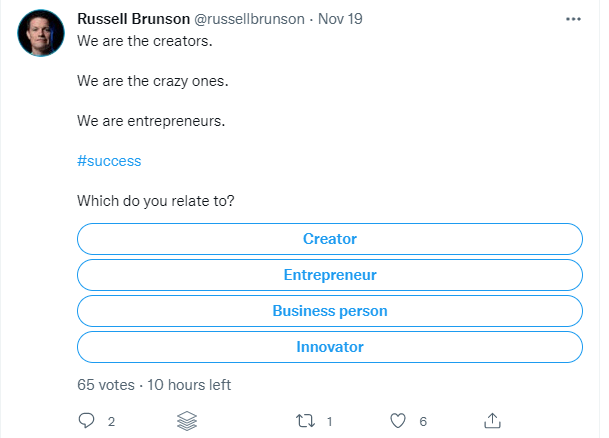

Or GIFs and memes using humor as an effective ice-breaker like Ann Handley on Twitter.

Or as a way of asking for feedback like Brendon Burchard’s on Facebook, which works best in terms of raising product awareness and community-building. Offering your audience the chance to speak their mind, whether it is in a post on your page or in a group, usually works wonders, as people enjoy being involved and getting a feeling of having the possibility to impact the final product.

3The News/Trending Post
If you are ever out of content ideas, try this – create a trending topics post. Since many people are following the news, they often check social media to find out what’s happening around the world.
This is a golden opportunity for entrepreneurs Mari Smith who is catching up with her audience while commenting on the global news. In the following example, she is taking advantage of industry trends to let her followers know that Facebook is changing its name to Meta.
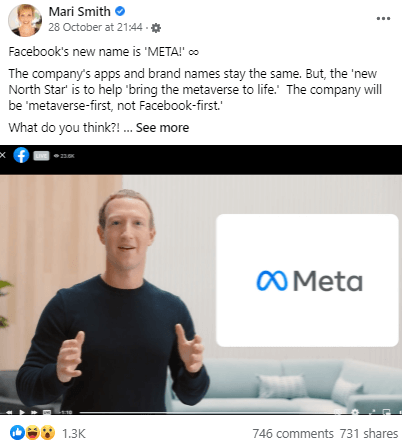
With a post that focuses on a major topic like this, Mari managed to start a discussion that encouraged lots of engagement.
4The Informative Post
If you are producing content for your blog, it’s always a good idea to share it on your social media. Besides, that’s the best place to share content like blog posts, articles that you have written or got featured, interviews you have given or conducted, as well as other types of visual content like infographics.
Larry Kim is regularly sharing content from different sources on his social media channels and particularly Facebook.

As an internet marketer, he is offering his audience key data on industry news and trends and posting relevant content.
To get started with content marketing yourself, conduct research key topic clusters and write articles addressing the interests and key pain points of your customers. You can also repurpose old content and use it throughout your social media accounts.
How-to guides are the most resourceful piece of content and many people take the time to read through them if it has relevant content they can use for their own projects or offer industry insights. While you are at it, make sure you also pay attention to SEO.
As a side note, Instagram has recently launched its Guides section, a place where you can gather both old and new content, and easily repurpose your top educational content. You can choose between three types of guides: places, products, and posts.
If you go with posts, you can easily create a step-by-step guide for example on the topics that your audience best responds to (based on your IG posts that have already been published), plus you can share it on other social media platforms.
Amy Porterfield created two guides, one on how to grow your email list and the other with a collection of the podcasts episodes.

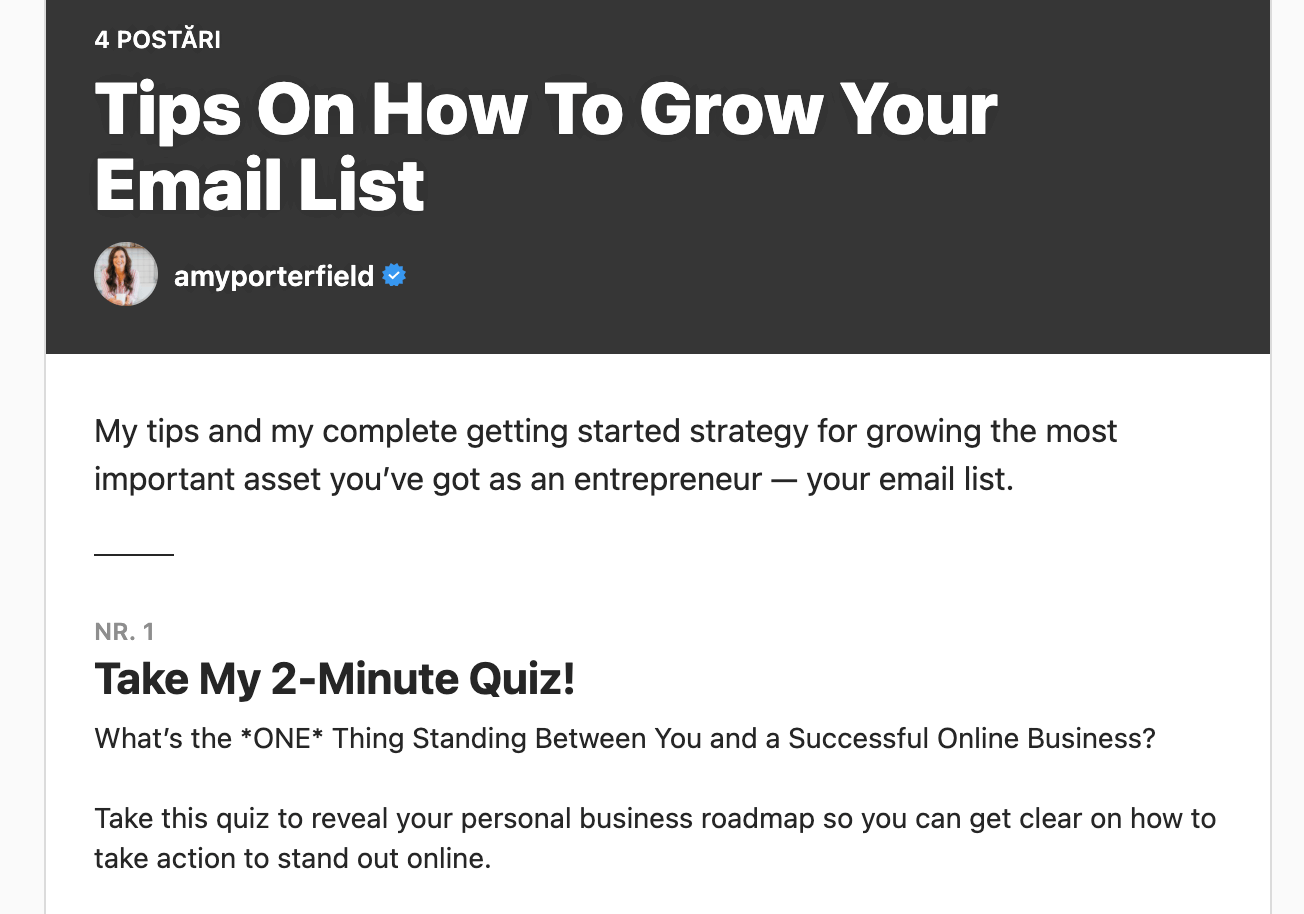
5The Giveaways/Competitions
Competitions and giveaway contests are great ways to engage with your audience. It’s fun and it offers a prize – which is an extra incentive for social media users to join in.
On her Instagram, Marie Forleo makes great use of giveaways to reach out to her audience and get them involved in her marketing campaign.

With a giveaway post like this Marie reinforces her #EverythingIsFiguretable campaign and invites people to take part and share their own stories. She uses hashtags to keep the conversation going and also gives a shout-out to one of her followers featuring their creations.
In the same way, you can work with your followers and other key influencers in your industry to promote your content, products, and services, and vice versa. Apart from individuals, you can also work with other brands.
6The Behind-The-Scenes Post
With behind-the-scenes content, you can show the parts of a project that not everyone gets to see, giving your followers the privilege and the opportunity to see what you are working on at any time.
Check out how Neil Patel does it on Twitter.

In this example, Neil is sharing his progress on a project while working from his armchair in the privacy of his home-sharing insights and updates to his followers as a Slack partner.
On a more personal level, Jenna Kutcher likes to share more intimate family moments with her audience on Instagram. Instagram Stories and posts are great for this type of content.
Jenna loves giving glimpses of her daily life, talking about her family and the baby they are expecting. Through all of her Instagram posts, she chooses to speak directly to her audience, and her audience appreciates her honesty and authenticity.

7The User-Generated Content Post
Featuring a case study is a great way to show potential customers what you can do for them. A customer testimonial highlighting the great value your online course offers can increase the trust in your brand and boost social proof.
Such posts feature real people – your customers, after using your product or service and sharing their experience with you and your company.
Twitter is a great platform for sharing testimonials since you can easily retweet and share content from other users on your profile, but Instagram is also a good choice.
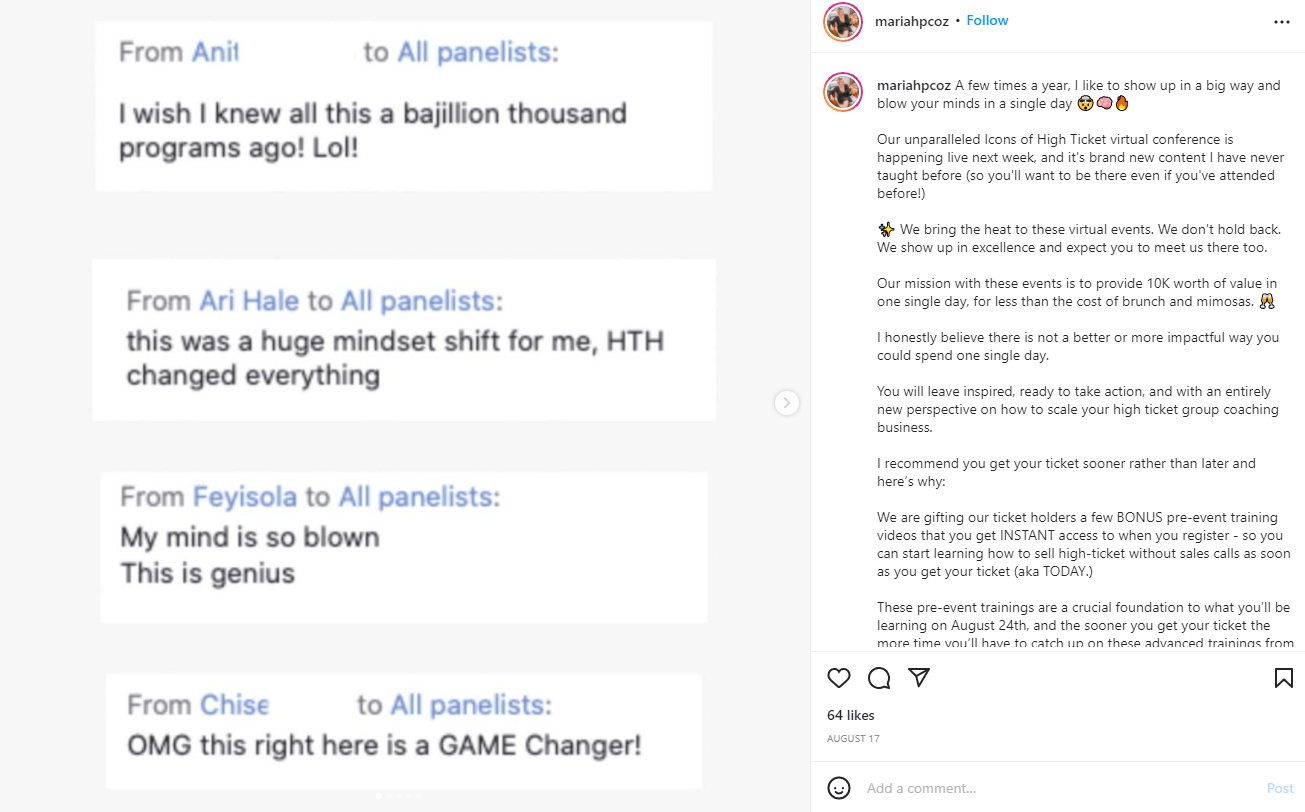
For example, Mariah Coz uses this popular social network to share some comments she received from her last virtual conference where participants talked about how useful they found the event. Then focusing on the benefits that her customers can take out from this, she offers them more great bonuses and incentives and invites them to join her at her next event.
Amy Porterfield also uses this type of content in order to promote some of her courses and bootcamps.
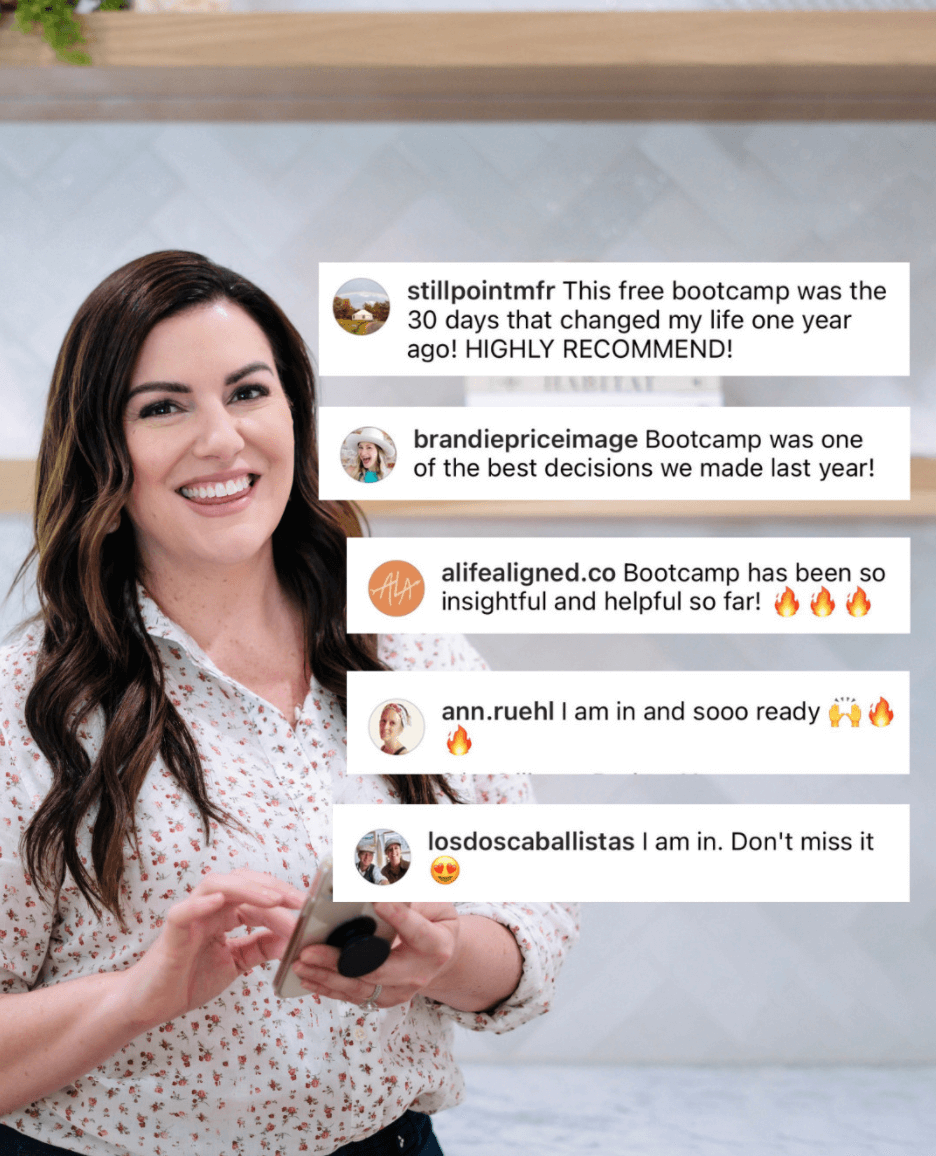
Here’s another great example from Danielle Leslie.

On Twitter, she re-shares a post created by one of her customers who already enrolled in her course on ‘Course from Scratch’ and enjoyed it. This is an excellent example of user-generated content (UGC) since the picture of the post is created by the customer and even mentions her name!
8The YouTube Video Post
Video content always gets the highest engagement rates because it is more direct, interactive and gives the chance to deliver information easier and quicker.
Jacques Hopkins, the creator of PianoIn21Days, often appears on social media using video. As a musician, he creates short video clips that give potential customers a sneak peek of what they can learn.
Through such posts, he also promotes his YouTube channel and his product – the online piano course that promises it will teach you how to play piano in 21 days.
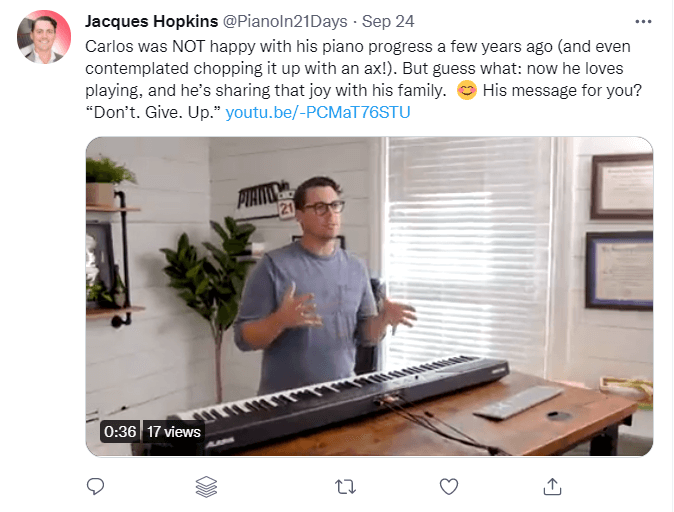
A video that shows a short tutorial clip or demonstration like this can help students navigate through your course and more likely to become interested in it.
If you are regularly creating video content for webinars and YouTube videos, make sure to add a link to your YouTube channel like Jacques does in this example, or to your course page where they can get more information about your course or purchase it right away.
9The ‘Live’ Post
The live video encourages people to connect with you at a profound level either by leaving a comment, reacting to it with emojis, or reaching out to you directly. If they find the live discussion useful, they may even share your content with their networks, which will get you more publicity.
Noah Kagan goes live on Facebook frequently and this communication method with his followers is working well judging from the engagement he gets every time.
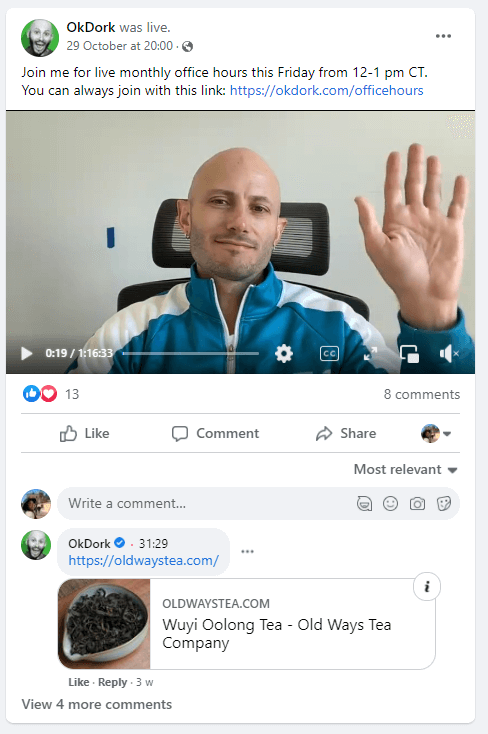
With Facebook Live, Noah has the opportunity to answer key questions from his followers and then give actionable tips, unique hacks, and advice that his audience can take away. His ‘monthly office hours’ allow entrepreneurs to ask whatever they want, and this shows how supportive he is to them.
Appearing live to your audience and responding to messages in real-time can be demanding but it helps to build an engaging online community over social media and increases brand loyalty.
Try to go live with Instagram, YouTube, or Facebook to test the general interest you get from your audience and see how it goes!
10The Inspirational Post
Inspiration is what makes this world go round, and everyone needs it every now and then. When used in the right context, it encourages people to do what’s best for themselves and others. And, there is no better place for it other than social media.
Simon Sinek likes to inspire others and proves it every single time he posts.
Most of his content on Instagram and Facebook are video clips from talks or podcast episodes giving out valuable pieces of advice and tips that people can use in their everyday lives.

Apart from that he also creates motivational statements and quotes and shares them across his other channels like Twitter – with less imagery, and Facebook.
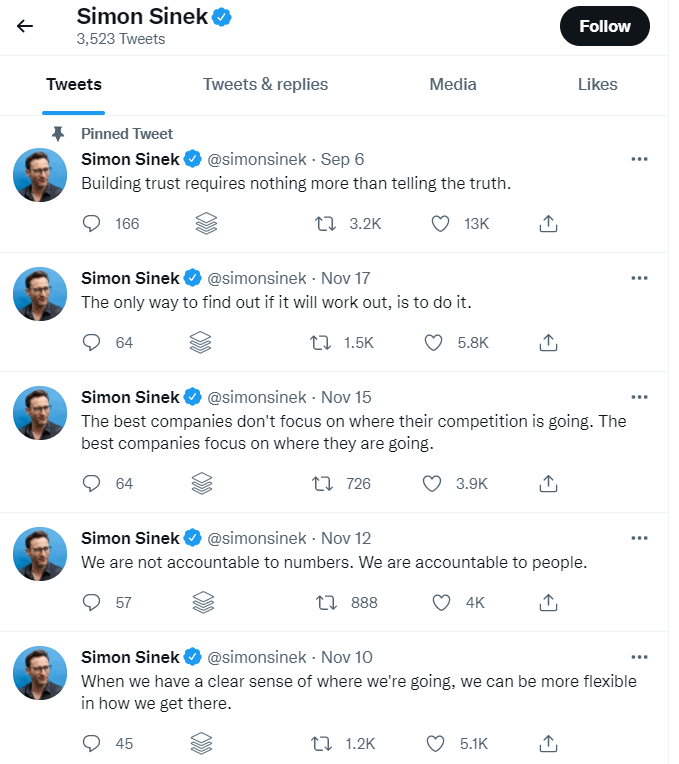
Inspiration is at the heart of everything Simon does, so he makes sure to post relevant content, introducing people to a challenge that will help them take action and grow.
Simon uses inspiration to get people on board the live online classes he conducts along with other successful coaches and instructors.
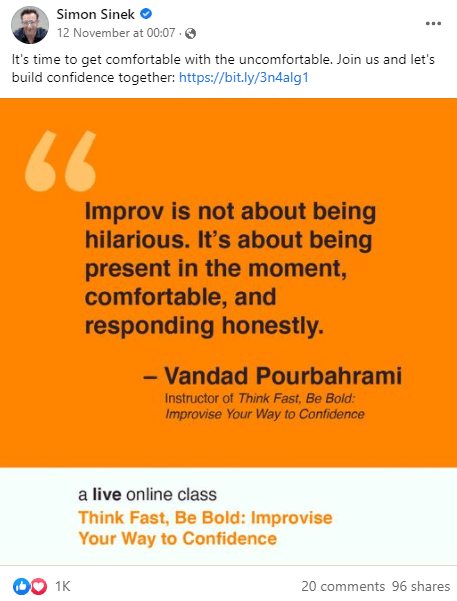
The link he adds in the post directs people to his online class registration page where users can opt-in with their email and book their place at the class for a price.
The goal of this post is ultimately to get more leads and sales.
11The Promotional Post
Promoting your online courses on social media can only bring you more leads and sales. So, whenever you have a special offer or discount, make sure to let your followers know about it.
If you have a coupon code, you can also share it with your new followers and give them an extra incentive as the newcomers.
In the following example, Sarah Cordiner is sharing a post featuring her latest seasonal offer on Black Friday. This goes out to course creators, coaches, consultants, and experts interested to learn more about course creation.
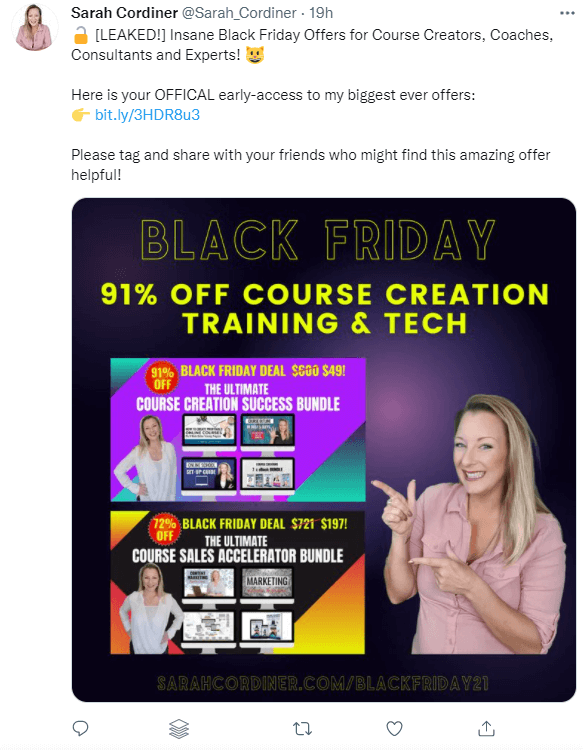
Sarah’s big deal is a course bundle and in the post, she is encouraging her followers to tag their friends in the thread, boosting awareness.
💡Hey, by the way, are you perhaps struggling to pick your next online course idea? Then our free webinar Choose Your (Next) Course Idea is the right one for you! Watch the webinar now and learn how to find your next big idea amd choose the perfect course topic!
If you want your social media management plan to be successful, you need to have a goal in place. Don’t just ‘post to post’ – but do it with a purpose – either to connect, to learn more about your audience, to start a conversation, to get leads, increase traffic or grow your business.
Also, think about what types of social media content will perform best and align more with the needs of your target audience.
An excellent way to do this is to put yourself in your customer’s shoes.
What would you expect to see more of if you were the customer? Focusing on the key pain points your audience is facing will help you explore the key topics in your industry in more depth and choose the one(s) that are worth investing more time, money, and effort in.
If you feel you lack inspiration, take a look at the communities where your target audience is present. Identify the types of posts that attract more engagement and create similar content pillar posts to test out on your pages.
Now, add these post ideas to your social media marketing strategy, and start creating and distributing content using them as content pillars and templates!
Are You Ready to Build Your Social Media Strategy?
Social media platforms present an enormous opportunity to all business owners – regardless of their industry, and the need to explore these is paramount.
While the majority most likely already have a Facebook page, it will need more than that to ensure followers will keep coming back, engage with your brand and buy your courses. What this calls for is a carefully thought content strategy that will bring the best results.
Ready to build a social media strategy and sell more courses? Get your free 30-day trial with LearnWorlds today!
Kyriaki is a Content Creator for the LearnWorlds team writing about marketing and e-learning, helping course creators on their journey to create, market, and sell their online courses. Equipped with a degree in Career Guidance, she has a strong background in education management and career success. In her free time, she gets crafty and musical.


